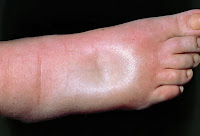Liddle's Syndrome
- it's inherited form of hypertension
- it's inherited in the form of Autosomal dominant pattern
- it's caused by mutation in the SCNN1A, SCNN1B, SCNN1G genes
- these genes provide instruction for making subunit of protein complex called epithelial sodium channel ( ENaC ) may found on surface of kidney cells
- Normally ENaC open in response to signals that Na level in the blood is too low, which allow reabsorption of Na back to the bloodstream
- if mutations occure, the ENaC will increase on cell surface leading to increase Na reabsorption and K exceartion
Features :-
- Begins usually early in life often in the childhood, some people aren't diagnosed until adulthood
- may be no additional signs or symptoms, but overtime if untreated, may develop heart disease or cerebrovascular accidents
- may suffer from signs and symptoms of hypokalemia as
* fatigue
* constipation
* heart palpitations
* metabolic alkalosis
Brugada Syndrome
- it's channelopathy disorder in the form of reduce sodium current
- inherited in the form of Autosomal dominant, typically in young, male, and othewise healthy normal
- it's a cause of polymorphic ventricular tachycardia which can develop to ventricular fibrillation leading to sudden death
- syncope and cardiac arrest are the most common clinical presentations
- nightmares may be found
- may subtle abnormality in right ventricle reported
- if you suspect Brugada syndrome do :-
* 12-lead ECG in all patient
* Drug challengewith sodium channel blocker if syncope with obvious cause * Electrophysiologic study * Serum K, Ca, CK-MB * Genetic test for mutation in SCN5A
Feature on ECG :- - incomplete RBBB
- ST elevation in anterior leads
three types of Brugada- Type 1 .... pronounced elevation of j point ( coved st ) and inverted t wave
- Type 2 .... saddleback st elevated by more than 1mm
- Type 3 .... st elevated less than 1mm
Treatment :-
the only treatment is implantable cardioversion defibrillator ICD.
* Drug challengewith sodium channel blocker if syncope with obvious cause
- incomplete RBBB
- ST elevation in anterior leads
three types of Brugada
- Type 1 .... pronounced elevation of j point ( coved st ) and inverted t wave
- Type 2 .... saddleback st elevated by more than 1mm
- Type 3 .... st elevated less than 1mm
the only treatment is implantable cardioversion defibrillator ICD.
Endothelin ... ET
- Family of 21 amino acids vasoconstrictors peptides
- three isoforms ET-1 ET-2 ET-3
- mediate their actions via two receptors ET-A ET-B
- ET-1 id the most potent
- ET-1 .....the major source is enfothelial cells then macrophages, fibroblast, cardiac myocyte, and neurons
- ET-2 ......Expressed in intestinal cells and at lower level in the heart
- ET-3 .....Expressed in brain neurons, kidney, and intestinal epithelial cells
- ET-2 & ET-3 differ from ET-1 in two and six amino acid repectively
- endothelin show very close structral and functional relationship to the snake venom peptide
- endothelins are released in the form of preproendothelin then undergone sequential prolytic processing by endothelin converting enzyme ECE
- ET-1 & ET-2 have the same affinity to ET-A but duffer to ET-B
- ET-3 binds to ET-B receptor so hence can be considered selective ET-B
Subscribe to:
Comments (Atom)



.png)





